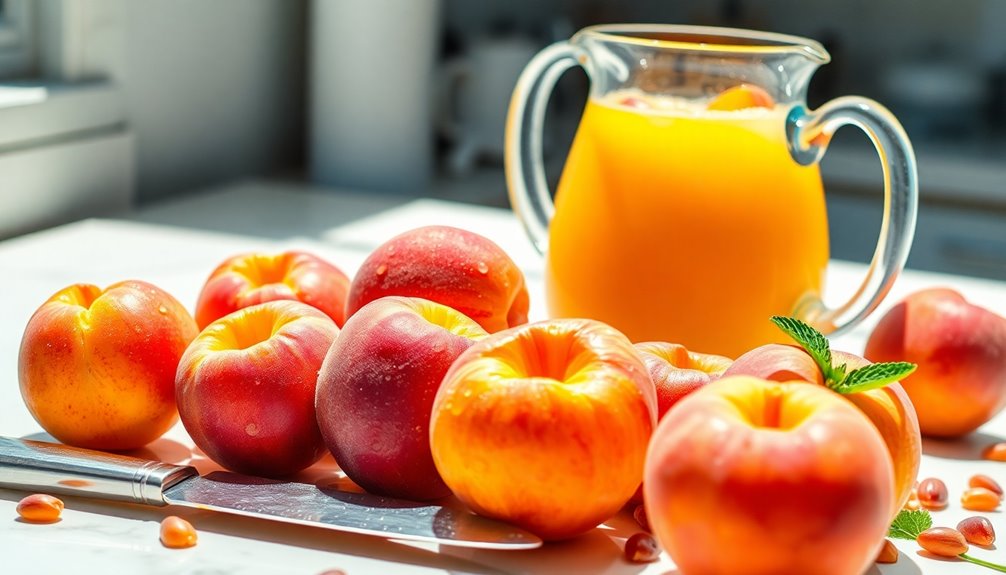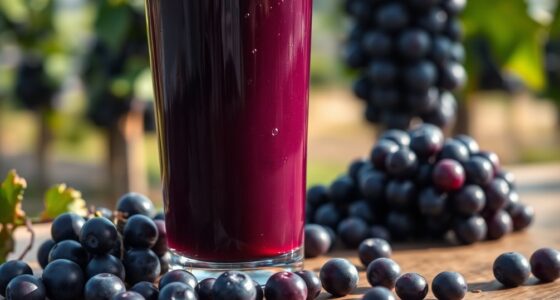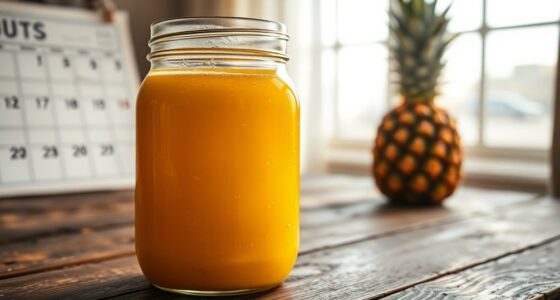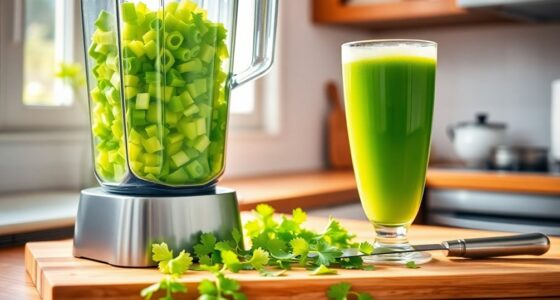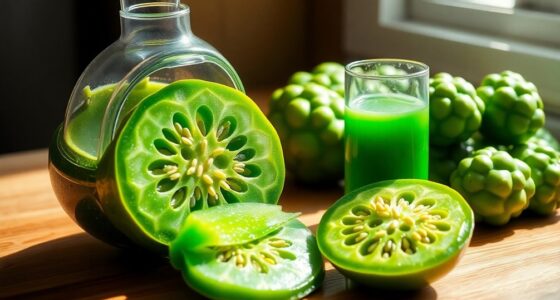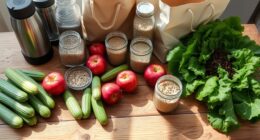To make peach juice, start by choosing ripe peaches that are slightly soft. Wash and slice them, removing the pits. If you have a juicer, use it for quick juice extraction; otherwise, blend the slices with a bit of water until smooth. Strain the mixture to separate the pulp. To enhance the flavor, add a sweetener like honey and a splash of lemon juice. Enjoy your fresh juice, and stick around for tips on using leftovers!
Key Takeaways
- Select ripe peaches that are slightly soft and free of bruises for the best flavor and juiciness.
- Wash the peaches thoroughly, then slice and remove pits before blending with a small amount of water.
- Strain the blended mixture through a fine mesh sieve to separate the juice from the pulp for a smoother consistency.
- Sweeten your juice with honey or maple syrup and add a splash of lemon juice for enhanced flavor and freshness.
- Store fresh peach juice in the refrigerator for 1-2 days or freeze in ice cube trays for longer preservation.
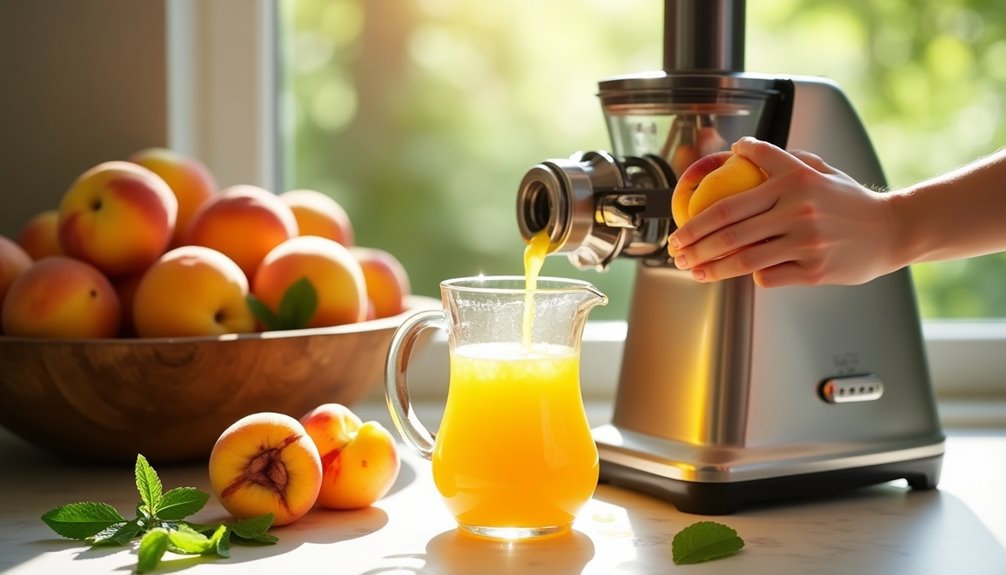
Making fresh peach juice is a delightful way to enjoy the sweet, juicy flavor of ripe peaches. Whether you're lounging on a sunny patio or hosting a summer gathering, there's nothing quite like sipping on homemade juice. The process is simple, and you can tailor it to your taste preferences. Start by selecting some ripe peaches; the more in-season and juicy they are, the better your juice will taste.
Begin by washing your peaches thoroughly to remove any dirt or residues. Next, you'll want to slice them, taking care to remove the pits and any bruised spots. If you prefer a smoother texture, use a juicer to make quick work of extracting the juice. However, if you don't have a juicer, the blender method works just as well. Simply blend the peach slices with a small amount of water until they're pureed.
Once blended, strain the mixture through a fine mesh sieve or cheesecloth to separate the pulp from the juice. This method allows you to control the thickness of your peach juice.
Sweetening your juice is entirely up to you. You can add a sweetener of choice, like honey, agave, or maple syrup, depending on how sweet you like it. A splash of lemon juice not only enhances the flavor but also prevents the juice from oxidizing, keeping it fresh longer. Just mix in your sweetener and lemon juice after you've strained the peach juice, adjusting to taste.
Fresh peach juice is best enjoyed right away, capturing that vibrant summer flavor. However, if you have leftovers, don’t worry! You can store your homemade juice in the refrigerator for 1-2 days. If you want to keep it for longer, consider pouring the juice into ice cube trays. This way, you can freeze it for up to three months, making it easy to enjoy a refreshing glass of peach juice whenever you like. Just pop out a few cubes, let them thaw, and you’re ready to go! For those who enjoy experimenting with different flavors, you can also mix peach juice with other fruits for a delightful twist. When it comes to how to store homemade orange juice, the same principles apply: refrigerate it for short-term enjoyment, or freeze in portions for long-lasting refreshment. With a little creativity, you can savor your favorite juices any time of the year!
Don't forget about the leftover peach pulp after making your juice. Instead of tossing it out, think about incorporating it into your smoothies or baked goods. It's a fantastic way to add extra nutrition and flavor to your recipes.
Frequently Asked Questions
How to Make a Peach Drink?
To make a peach drink, you'll want to start with ripe peaches. Blend them with cold water until smooth, adding honey or agave syrup if you like it sweeter.
Strain the mixture to get rid of the pulp for a smoother texture. For extra flavor, squeeze in some lemon or lime juice.
Chill your drink in the fridge or pour it over ice to enjoy a refreshing treat on a hot day!
Do You Have to Peel Peaches Before Juicing?
You don't have to peel peaches before juicing them, but it really depends on your preference.
If you enjoy a smooth texture, peeling might be best, as the skins can make the juice thicker. On the other hand, keeping the skins adds nutrients and fiber.
If you're using non-organic peaches, it's smart to peel them to avoid pesticides.
Ultimately, it's your choice based on how you want your juice to taste and feel!
What Are the Ingredients in Simply Peach Juice?
When it comes to Simply Peach Juice, you're in for a treat! The main ingredient is 100% ripe peaches, delivering a fresh and natural flavor.
Sometimes, a splash of water's added to get the right consistency. For a citrus twist, you can toss in a bit of lemon juice.
If the peaches aren't sweet enough, you might consider adding honey or agave syrup. It's all about enjoying pure, wholesome goodness without any artificial additives!
How to Make Juice Step by Step?
To make juice step by step, start by washing your fruit thoroughly.
Next, cut it into pieces, removing any pits or seeds.
If you have a juicer, feed the pieces in; if not, blend them with a bit of water until smooth.
Strain the mixture if you want a smoother texture.
Finally, sweeten it to your taste, and enjoy your fresh juice!
Remember to store any leftovers properly in the fridge or freezer.
Conclusion
As you pour the golden peach juice into a glass, think of it as capturing summer in a bottle. Just like the sun ripens peaches, your effort brings out their sweet essence. Each sip is a moment of sunshine, a reminder that simple pleasures can brighten your day. So, embrace the process, savor the flavors, and let your homemade peach juice be a refreshing oasis, a little treasure from nature's bounty. Cheers to your delightful creation!
Cindy thoroughly researches juicing trends, techniques, and recipes to provide readers with practical advice and inspiration. Her writing style is accessible, engaging, and designed to make complex concepts easy to understand. Cindy’s dedication to promoting the advantages of juicing shines through her work, empowering readers to make positive changes in their lives through the simple act of juicing.

